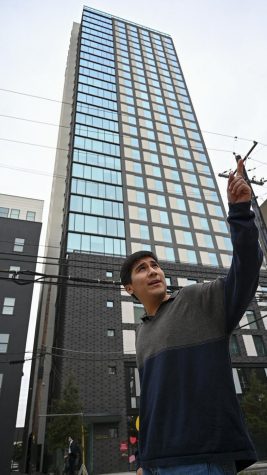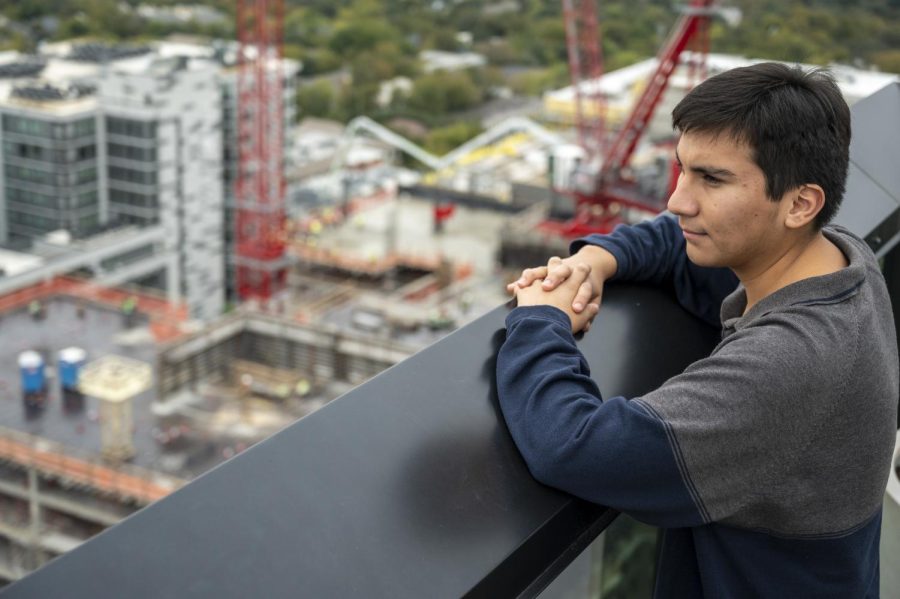As cost of living in West Campus rises, students seek relief
November 18, 2022
People know West Campus for its convenient proximity to UT, its massive student population — and over the past few years — its booming rent prices.
Rent in West Campus hasn’t increased as much as in other parts of Austin, but the affordable places students can live near campus continue to dwindle as luxury student complexes rise in height and numbers each year. Instead, many low-income students opt to commute to campus and live in East Riverside — but the rent’s still rising there, and often unreliable public transportation means more time and money spent getting to campus. While the city offers some affordable housing options in West Campus and UT is beginning to address affordability issues, these options are still limited.
West Campus’ rapid expansion over the last 18 years isn’t by accident — 78705 is now the third most densely populated zip code in the state, because of the 2004 University Neighborhood Overlay district. The plan excluded the area from aspects of Austin’s strict permitting process and allowed developers to build as high as 175 feet in exchange for offering some units through Austin’s SMART affordable housing program. By 2019, the Austin City Council voted to allow developers to build up to 300 feet –– as high as the UT Tower.
Waterloo Tower did just that and currently stands taller than any building in West Campus. Of its 241 units, 20% are priced below typical market rates. Half of the affordable units are for residents that earn less than 60% of Austin’s median family income, which was about $109,000 a year in 2021, and the other half is for people earning less than 50%.

Until he signed his lease at Waterloo, philosophy and government sophomore Nathdaniel Rodriguez said he didn’t know he qualified for SMART housing.
“I saw a very good rate, like ‘That’s kind of ridiculous, let me apply and see what happens,’” Rodriguez said. “They were like ‘Oh, do you qualify for SMART housing?’ and I was like ‘I don’t know what that means.’ I signed it, and a couple days later I saw that (the affordable rooms were) sold out.”
The SMART program may need a more comprehensive database to determine students’ eligibility and list available housing, said associate professor Jake Wegmann, whose research focuses on housing affordability and regional planning. Students currently find SMART housing options through an individual apartment’s leasing process, which means it’s up to the students to find affordable housing on their own — if they’re even aware the program exists.
With buildings renewing leases for the next academic year as early as October, the market remains competitive, even for affordable housing. Rodriguez said he wishes he knew about the option when he was a freshman.
“SMART housing units go away really quickly,” Rodriguez said. “I wouldn’t have known about it before I even committed.”
Student Government’s advocacy board tries to help connect students struggling financially to resources they may not know about, such as the Student Emergency Fund, which offers assistance for financial burdens such as food insecurity and utility bills, the city’s affordable housing directory, which details options all over Austin, and UT’s off-campus housing marketplace, which lists living options for students, committee director Isabel Richards said.
Is West Campus Too Expensive?
It depends on who you ask.
Since 2020, West Campus rent has increased by 15%, according to the U.S. Department of Housing and Urban Development data. And while that may seem like a lot, the rates are lower compared to all of Austin, which saw a price increase of 27%. Construction of new complexes is keeping a cap on rent in the neighborhood, Wegmann said, because increasing infrastructure means less competition for available or occupied rooms.
“According to that data, yes, rents have gone up in West Campus, but the rents have basically risen at the same rate as inflation or in some cases have risen less than inflation,” Wegmann said. “The rents in West Campus have gone up by a lot less than Austin as a whole.”
Regardless of how rent compares to the rest of the metroplex, students with no or low income still need an affordable place to live. When prices are too high near campus, students opt to commute, such as those that live in East Riverside.
Curriculum and instruction graduate student Savannah Anderson-Knight moved to Riverside in 2019, joining approximately 3,000 Longhorns who live in some of the apartment complexes in the area. She was unsure if she wanted to renew her Riverside lease this fall due to issues such as inconsistent buses to campus, she said, but ultimately decided to stay. Her initial renewal lease would keep rent at the same rate of $720 a month. Then management changed and her rent shot up by $500, she said, and lease terms weren’t resolved until she involved legal counsel.
“We were like, ‘Well, I guess I’m stuck here,’” Anderson-Knight said.
Riverside has long been an affordable option for student housing. But some of the students in Riverside’s main four apartment buildings may face further issues trying to find affordable housing, when their rooms are demolished to make space for the “Domain on Riverside,” a new office, retail and commercial development. Despite students protesting against the apartments’ demolishment for the development, city council members approved it in 2019. The project, now called River Park, aimed to seek city approval in early 2022 when it released the first phase plans in July last year.
Where do we go from here?
Insufficient affordable housing isn’t unique to Austin, but the city has some unique issues. Austinites identified lack of affordability as the city’s biggest issue in a July poll.
A federal bill introduced this year aims to lower rents based on area median income and increase affordable housing options for a federal low-income housing assistance program. Currently, State Rep. Gina Hinojosa, who represents parts of Austin, said she is focusing on drafting a bill that would require landlords to consider federal student loans and education related incomes as income for rental qualification.
“We need a federal solution to this,” Hinojosa said. “I know Congress recently did some hearings on buyers buying up all the middle-income housing. … I think it’s a good sign, but there’s just too much power and wealth in the hands of too few, and it’s leaving everybody behind.”
Wegmann said housing reform stands on three legs: protecting those with insecure housing, subsidizing affordable housing from local governments, and changing laws to streamline the building process of new developments.
The housing debate is often between those in favor of constructing new developments and those in opposition who want subsidies for those who can’t afford the new developments’ prices, Wegmann said. However, he said the solution is to have both.
“There’s no real conflict between them,” Wegmann said. “When you build lots of stuff, then you’re lowering the rate at which rents are going up. But there are always going to be people who can’t afford the new housing and so you have to give them substitutes so that they get to live in the neighborhood, too.”
The University can do more to serve the housing needs of its first-generation and low-income students, Wegmann said, perhaps by building housing with private developers.
When first-generation students live closer to campus, he said, they’re more likely to succeed and graduate college because they’re not spending time commuting. The University recently purchased Dobie 21 and began constructing graduate student housing in East Campus. But long-term initiatives take time, Wegmann said.
In September, President Jay Hartzell told The Daily Texan the University is looking for solutions UT can take to address the affordability crisis and they plan to commit at least $1 billion of the $6 billion What Starts Here campaign towards the issue.
“The University is kind of like an aircraft carrier — it can’t do anything on a dime,” Wegmann said. “But once it starts doing something and it has a lot of muscle behind it, it has a lot of resources at its disposal.”












